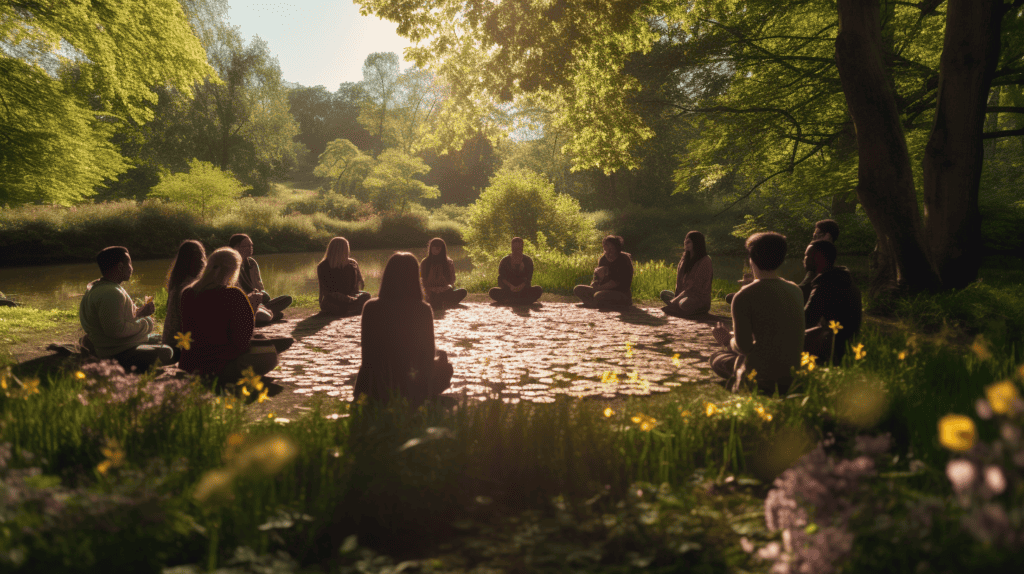Life can sometimes be a whirlwind of things to do, making it difficult to find time to meditate. But finding silence and tranquility, even in the midst of a busy life, can bring countless benefits. As practiced meditators will tell you, being able to control your thoughts during meditation is akin to having a superpower. Studies have shown the immense benefits that come from a regular meditation practice, including higher productivity and lower stress levels.
As someone looking to start or deepen a meditation practice, finding the right place to meditate can make all the difference. While meditation can be done anywhere, having a peaceful, quiet, and comforting space helps create the ideal conditions for going within. You might find it handy to use a meditation app to guide you through different styles and techniques. So, let’s look at where can I meditate.
Key Takeaways
- Dedicated spaces like a special room in your home are ideal but not mandatory for building a meditation routine.
- Get creative and transform ordinary places like your bed, couch or office into your own mindfulness sanctuaries.
- Nature settings like parks, gardens, forests, and bodies of water provide soothing sounds and scenery to enhance meditation.
- Take advantage of quiet public places you already frequent like libraries, places of worship, waiting rooms and public transit.
- Studios, meditation centers, and temples offer community support and guidance.
- Practice consistently by setting aside time to meditate morning and night or on your lunch break.
- Micro-practices throughout your day build mindfulness little by little.
In this article, I’ll share 21 places where you can meditate based on my personal experiences over the past 10 years. I’ve discovered that having dedicated spaces for meditation helps me show up more consistently. But don’t worry if you don’t have a special meditation room – with some creativity, you can transform ordinary spaces into your own personal mindfulness sanctuary.
At Home
Meditating at home allows you to relax in a familiar environment fully. You can meditate right on your bed, couch, or floor, creating an inviting nest conducive to your practice. Here, your thoughts have the freedom to drift and you can practice silence to contemplate the world around you.
Bed
Sitting up in bed against the headboard or pillows provides great back support for longer sits. Make sure to set an alarm so you don’t end up taking an unplanned nap!
Tip: Keep a meditation cushion or pillow on your bed as a reminder to practice first thing in the morning or before bed.
Couch
The couch provides a comfortable place to sit cross-legged or with your feet on the floor. Use pillows for extra back support. Sitting upright helps maintain alertness, but lying down works, too if you need rest.
Tip: Face away from the TV to avoid distraction. Cover with a blanket to feel cozy.
Floor
Sitting on the floor allows you to align your spine properly and feel grounded. Use a meditation cushion or firm pillow to elevate your hips above your knees.
Tip: Place a yoga mat or blanket underneath you for padding. Sit against a wall for support.
Special Meditation Room
Creating a dedicated meditation space cultivates positive energy and serves as a visual reminder. Decorate it minimally with items like crystals, inspirational quotes, candles or spiritual imagery. Keep it tidy and only use it for meditation. Studies have shown that having a dedicated space can heighten the benefits of meditation, which can range from improved mental health to better performance at work or school.
Healthline highlights the benefits of meditating in a community center or meditation group setting, which can provide support and a sense of belonging.
Tip: Store your cushion, mat, shawl, meditation journal and supplies in your meditation room so they are easily accessible.
Outdoor Spaces
Connecting with nature while meditating enhances mindfulness. Natural settings provide fresh air and soothing sounds to relax the mind.
Backyard
Find a quiet spot in your backyard to sit and meditate surrounded by trees, plants, and fresh air. Place a cushion or chair on the grass or a patio or deck.
Tip: Meditate at sunrise to energize your day with clarity and intention.
Park
Parks provide pockets of nature within cities. Look for a grassy area, bench or picnic table away from the playgrounds to sit calmly and privately. Close your eyes and bask in the sounds of birds chirping and beautiful forest trees.
Tip: Arrive early or later in the day when it’s less crowded. Sit facing away from walking paths.
Beach
The ocean has a meditative quality, with the constant rhythm of the waves. Sit on the sand facing the water and allow the crashing waves to anchor your awareness on sound. Early mornings are quietest.
Tip: Bring layered clothing and a blanket to stay warm. Use headphones if needed to buffer wind noise.
Garden
Public gardens offer secluded nooks, fountains and fragrant flowers to enhance mindfulness. You often get a sense of tranquility and peace there, almost like wearing the most comfortable pair of shoes. Slowly stroll through the grounds, making it somewhat like a mindfulness training course. Then, pause to meditate on a bench surrounded by nature’s beauty. Botanical gardens at universities are often free to visit and sometimes incorporate parts of mindfulness in their own way.
Tip: Go on weekdays when gardens are less crowded. To make your visit a part of your routine, gather articles or materials with questions that can enhance your mindfulness experience. Pause to meditate at your favorite spot along the winding paths.
Lake, Pond, or River
Bodies of water create serene settings for meditation. Sit near the shoreline and listen to the gentle lapping of the water. Gaze at the soothing movement and reflections on the surface. This is not just something to do, but a part of developing your mindfulness.
Tip: Pick a peaceful area away from boat launches or trails. Arrive at sunrise to avoid crowds and if you have questions about the best spots, don’t hesitate to ask local experts.
Woods
Forests or nature preserves provide ideal spots to meditate surrounded by majestic trees. Their quiet energy invites inner stillness and centering. Look for a clearing or fallen log to sit on. Like the grounding sense of wearing your favorite shoes, it gives you stability and comfort.
Tip: Bring a blanket to sit on damp ground or brush. Pause during hikes for impromptu mindfulness sessions and consider these pauses as part of your mindfulness training.
Mountain Summit
Reaching a mountain summit after a long hike creates a perfect opportunity for meditation. Feel one with nature as you sit quietly, taking in the views. Appreciate this moment of accomplishment and inner tranquility. This is not just reaching the top of a mountain but also the course of your spiritual journey.
Tip: Watch the sunrise or sunset from a mountain perch for a transcendent experience. Remember, the journey to mindfulness is not a race, but something to be practiced consistently.
Everyday Spaces
With creativity, many ordinary public places can also lend themselves nicely to meditation. Consider the following options as you move around town for your daily activities. Keep an open mindset and heart, treat each experience as a training in mindfulness and as something valuable in itself.
Gaiam notes the effectiveness of meditating in your office or workspace for short periods to reduce stress and improve focus during the workday.
Library
Libraries offer free quiet spaces to practice mindfulness. Find a couch, chair or even the floor of a basement stack area to sit undisturbed. Breathe in the calming smell of books, just like the comforting sense of your favorite shoes embracing your feet.
Tip: Borrow meditation CDs or books to further your practice. Schedule a study room for uninterrupted time.
Place of Worship
Churches, synagogues, mosques and temples welcome quiet contemplation. Sit in a pew, classroom or garden on their grounds. Feel the sacred energy as you meditate.
Tip: Attend a meditation service and stay afterwards to continue sitting in the peaceful space, feeling each part of the spiritual discourse enrich your inner being.
Lobby or Atrium
Find a couch, chair or bench in the lobby or atrium of any large public building. Close your eyes and tune out the bustle around you as you follow your breath. Office buildings after hours work nicely.
Tip: Use white noise headphones and a neck pillow if needed to create privacy. Use it as an impromptu training session for your mindfulness journey and allow it to be a part of your everyday routine.
Museum
Find a quiet corner in a museum to sit and center yourself surrounded by beauty and history. Appreciate the pause from actively viewing exhibits. Meditate on a bench in a sculpture garden.
Tip: Go on weekday mornings when it’s less crowded. Sit facing a calming photograph or painting, and quietly ask yourself questions about what you see and feel.
Bus or Train
Use commute time or long rides for impromptu meditation sessions. Sit comfortably with eyes closed and spine erect. Sway gently with the motion while focusing on your breath or a mantra.
Tip: Sit near a window for natural light and views. Wear your comfortable shoes and use headphones if the ride is noisy to create a sense of privacy.
Airport
Find an empty gate area, baggage claim section or other public seating at the airport to stop and meditate during layovers or delays. Make this a vital part of your mindfulness training while on the move, no matter where you are, you can always find peace in mindfulness.Ideally, look for a quieter space away from crowds. In a world full of distractions and noise, it’s kind to yourself to seek tranquility.
Tip: Bring earplugs, an eye mask, and a travel pillow to create privacy anywhere. Stretch before flights to relieve stress and prepare your body. Listen to calming music if kids are causing distractions.
Waiting Room
Turn time spent in clinic, salon, or government waiting rooms into an opportunity to meditate. Find a chair away from others, set a timer, and close your eyes. You can also explore additional ways to meditate, such as writing about your feelings on a blog or visualizing healing or gratitude.
Tip: Ask to be seated in the emptiest corner. Use headphones or earplugs if it is noisy.

Meditation Studios
For those looking for a guided practice or community, meditation studios provide the perfect space to strengthen your skills alongside like-minded others.
Yoga Studio
Many yoga studios offer meditation classes and open sit times before or after yoga. The tranquil space will be conducive to sitting. Check their schedule for meditation-focused classes like breathwork.
Tip: Ask about renting studio time for your own personal practice. Coordinate group sits with fellow students to create a supportive community.
Meditation Center
Dedicated meditation retreat centers focus specifically on offering classes, retreats, and open sit times. Teachers provide guidance on proper technique and integrating mindfulness philosophies into your daily life.
Tip: Ask about beginner workshops to learn fundamentals before joining group sits. You can also learn from different blog posts and online resources about meditation.
Buddhist Temple
Buddhist temples may offer public meditation times as well as multi-day retreats. Sitting with the sangha, or community, provides support. Temple stays also allow extended periods of practice.
Tip: Attend on festival days to experience chanting or dharma talks. Arrive early to help set up cushions. This might be a unique experience that you could share in your blog.
Establish A Regular Practice
To make meditation an ongoing habit, intentionally setting aside time and picking favorite spots helps. Experiment with different locations day to day. Feelings of contentment can come from a variety of places, so don’t limit yourself to one specific spot.
Morning
The quiet morning hours are perfect for centering yourself and setting intentions before the busy day begins. Follow your sit with mindful movement or journaling, accompanied by some soothing morning music.
Tip: Keep a cushion on your bedroom or living room floor to make morning practice easy. Create a corner specifically for meditation, with comforting scents and soothing music to help focus your mind.
Lunch Break
Reenergize midday by closing your office door and taking a meditation break. Set a timer for 10-15 minutes. Notice any feelings of stress melt away.
Tip: Stretch first to wake up your body. Keep a desk cushion or use a chair. Blog your experiences as a way to refocus and reflect.
Commute
If driving or commuting via public transit, take advantage of this transition time to practice mindfulness. Let the movement rock you as you connect with your inner self despite the distractions of the external world.
Tip: Record guided meditations to listen to on headphones during commutes.
Before Sleep
Close your day by meditating in bed to turn down the nervous system. Feel your body sink into the mattress as your mind quiets down for rest.
Tip: Dim the lights, keep eyes closed and focus on slow belly breaths. There are different ways to integrate calm and mindfulness – find what works best for you.
Micro-practices
Integrate brief 1-5 minutes meditations into your day. Set a chime on your phone or watch to remind you to pause and take a few mindful breaths.
Tip: Try mindful walking to your car or as you wait in line. Be present during routine tasks and consider writing about your journey on a blog. Understanding your feelings through reflection can be just as healing as the meditation practice itself.
Conclusion on Where Can I Meditate
The key is to intentionally set aside time to meditate, no matter how brief. Start where you are, using whatever space and resources you have available. Don’t worry about clearing your mind, getting the posture perfect, or sitting for long periods. Embrace the world of meditation with all its variety and ways of practicing.Be gentle with yourself, let go of self-judgment, and remember to be as immovable as mountains when facing any difficulties. Just come back to your breath again and again, like an author coming back to the main point of writing his story. With regular practice, using your brain in such a nurturing way, you’ll be able to access more peace, focus, and joy. As a person yearning for serenity, wishing you many transformative meditations ahead on your journey, wherever you choose to sit. Let this journey be your logo, your emblem of tranquility.
FAQ on Places to Meditate
Q: Where is a great place to meditate for a beginner?
A: There are many places where beginners can start their journey into mindfulness and meditation. Some of the best places to meditate include quiet spots in nature, like high mountains where distractions are minimal, dedicated meditation centers with an author-like meditation teacher who teaches with clarity, or even the privacy of your own home. The key is finding a location where you feel at ease, where distractions do not prick your brain and you, as a person, feel comfortable.
Q: I’m a beginner, how can I learn how to meditate?
A: Starting a regular meditation practice can be facilitated by a meditation teacher who can share methods of teaching meditation like an author sharing a plot point. Alternatively, you can use guided meditations or meditation apps that provide step-by-step instructions. As a beginner, remember it’s okay if your mind wanders, just bring it back to the present moment like drawing back a logo, and focus on your breath.
Q: Is it necessary to find a great place to meditate or can I do it anywhere?
A: While it’s nice to have a dedicated spot that’s quiet and free from distraction, like the serenity of the mountains, it doesn’t matter where you meditate just as long as your brain finds comfort. Many people make meditation a habit by integrating it into their daily routines, meditating even without a specific spot. Remember, the most important thing is the mindfulness practice itself, not the location. This mindset would be the unique logo of your journey.
Q: Can I really transform my mind through meditation?
A: Absolutely. As per meditation experts, regular mindfulness meditation can greatly contribute to mental clarity and emotional balance. Over time, we’re learning to be more present in the moment, reducing anxiety and stress levels, thereby transforming our mind just as an author might revise a crucial plot point in a story.
Q: What type of meditation should I practice?
A: The practice of meditation can be as diverse as the mountains are sprawling. It very much depends on the individual. Some might find mindfulness meditation helpful, where you focus on the sensation of your breath, while others might prefer guided visualization. There’s no such thing as a perfect meditation practice – it’s about searching and finding what works best for you and helping you stay in the present moment.
Q: What are some of the best places to meditate?
A: The best places to meditate are those where you can relax and won’t be easily distracted. It could be a local park, a quiet beach, high in the mountains, a dedicated meditation center, a corner of your home, or even a secluded place in your office. The key is to choose a location where you, as a person, feel serene and can focus on your meditation.
Q: Should I see my doctor before starting a meditation practice?
A: In the same way an author would consult a publisher before proceeding, anyone starting meditation usually doesn’t need a doctor’s approval, as it’s generally safe for most people. However, just as a logo needs to fit its brand, if you have physical health issues or mental health concerns that might influence your ability to sit quietly or focus your mind, it’s always advisable to consult with your doctor or a mental health professional.
Q: How can I maintain a regular meditation practice?
A: Make meditation a habit by integrating it into your daily routine – try to meditate at the same time each day and aim for consistency rather than length of practice, just as a professional mountain climber would train. Even a few minutes daily can be beneficial. Don’t chastise yourself if you miss a session – just try to get back on track the next day, keeping your goal, your logo, at the forefront of your mind. Remember, it’s about maintaining mindfulness and meditation in an enjoyable way, not as a task.
Q: Can meditation be effective even without a meditation teacher?
A: Yes, it can. While a meditation teacher can provide guidance and answer queries you have, meditation is essentially an individual practice that centers your mind on the present moment. You can learn how to meditate through books, online tutorials or apps that guide you through the process.
Q: I keep getting distracted during meditation. Is that okay?
A: Yes, that’s okay. It’s completely normal for your mind to wander during meditation. When you notice that you’re not focusing on your breath or the present moment, simply acknowledge the distraction and gently guide your focus back to the breath. Don’t judge yourself—remember, the process of returning to mindfulness is, in itself, meditation.





Leave a Reply